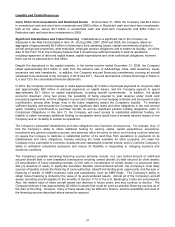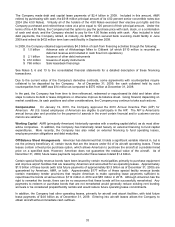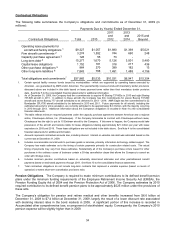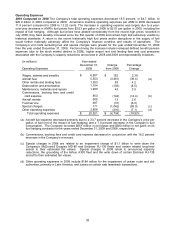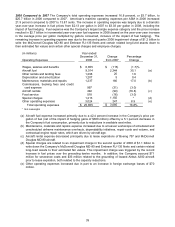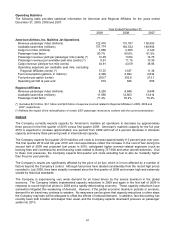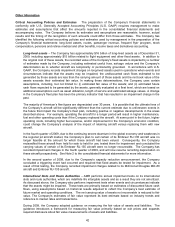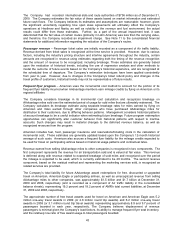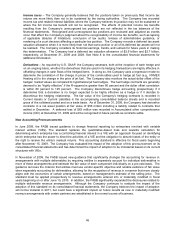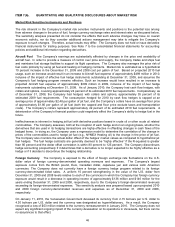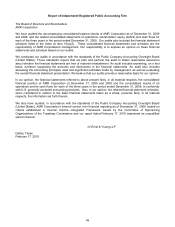American Airlines 2009 Annual Report Download - page 44
Download and view the complete annual report
Please find page 44 of the 2009 American Airlines annual report below. You can navigate through the pages in the report by either clicking on the pages listed below, or by using the keyword search tool below to find specific information within the annual report.
41
Operating Statistics
The following table provides statistical information for American and Regional Affiliates for the years ended
December 31, 2009, 2008 and 2007.
Year Ended December 31,
2009
2008
2007
American Airlines, Inc. Mainline Jet Operations
Revenue passenger miles (millions)
122,418
131,757
138,453
Available seat miles (millions)
151,774
163,532
169,906
Cargo ton miles (millions)
1,656
2,005
2,122
Passenger load factor
80.7%
80.6%
81.5%
Passenger revenue yield per passenger mile (cents) (^)
12.28
13.84
12.75
Passenger revenue per available seat mile (cents) (^)
9.91
11.15
10.39
Cargo revenue yield per ton mile (cents)
34.91
43.59
38.86
Operating expenses per available seat mile, excluding
Regional Affiliates (cents) (*)
12.22
13.87
11.38
Fuel consumption (gallons, in millions)
2,499
2,694
2,834
Fuel price per gallon (cents)
200.7
302.6
212.1
Operating aircraft at year-end
610
626
655
Regional Affiliates
Revenue passenger miles (millions)
8,255
8,846
9,848
Available seat miles (millions)
11,566
12,603
13,414
Passenger load factor
71.4%
70.2%
73.4%
(*) Excludes $2.5 billion, $3.1 billion and $2.8 billion of expense incurred related to Regional Affiliates in 2009, 2008 and
2007, respectively.
(^) Reflects the impact of the reclassification of certain 2007 passenger revenues to conform with the current presentation.
Outlook
The Company currently expects capacity for American’s mainline jet operations to decrease by approximately
three percent in the first quarter of 2010 versus first quarter 2009. American’s mainline capacity for the full year
2010 is expected to increase approximately one percent from 2009 with half of a percent decrease in domestic
capacity and nearly three percent growth in international capacity.
The Company expects first quarter 2010 mainline unit costs to increase approximately 9.2 percent year over year.
The first quarter 2010 and full year 2010 unit cost expectations reflect the increase in the cost of fuel during the
second half of 2009 and projected fuel prices in 2010, anticipated higher revenue-related expenses (such as
booking fees and commissions) and financing costs related to Boeing 737-800 and other aircraft deliveries. Due
to these cost pressures, the Company expects first quarter unit costs excluding fuel to also be modestly higher
than the prior year periods.
The Company’s results are significantly affected by the price of jet fuel, which is in turn affected by a number of
factors beyond the Company’s control. Although fuel prices have abated considerably from the record high prices
recorded in July 2008, they have steadily increased since the first quarter of 2009 and remain high and extremely
volatile by historical standards.
The Company is experiencing very weak demand for air travel driven by the severe downturn in the global
economy. The Company initially implemented capacity reductions in 2008 and again in the first half of 2009 in
response to record high fuel prices in 2008 and a rapidly deteriorating economy. Those capacity reductions have
somewhat mitigated this weakening of demand. However, if the global economic downturn persists or worsens,
demand for air travel may continue to weaken. No assurance can be given that capacity reductions or other steps
the Company may take will be adequate to offset the effects of reduced demand. In addition, fare discounting has
recently been both broader and deeper than usual, and the Company expects downward pressure on passenger
yields into 2010.


